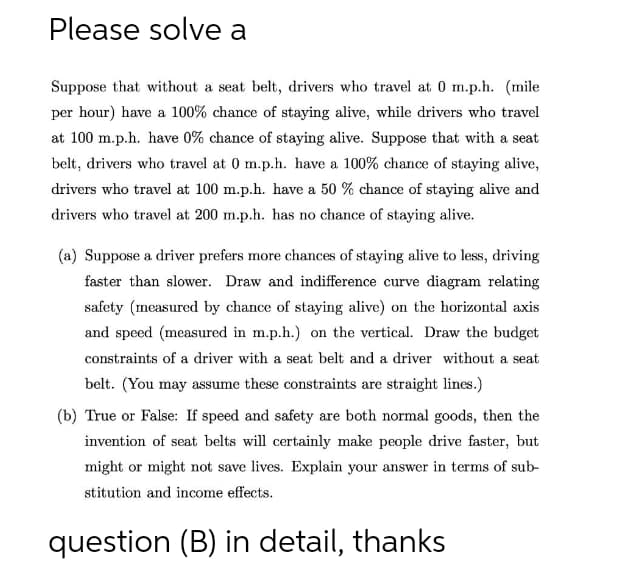Please solve a Suppose that without a seat belt, drivers who travel at 0 m.p.h. (mile per hour) have a 100% chance of staying alive, while drivers who travel at 100 m.p.h. have 0% chance of staying alive. Suppose that with a seat belt, drivers who travel at 0 m.p.h. have a 100% chance of staying alive, drivers who travel at 100 m.p.h. have a 50 % chance of staying alive and drivers who travel at 200 m.p.h. has no chance of staying alive. (a) Suppose a driver prefers more chances of staying alive to less, driving faster than slower. Draw and indifference curve diagram relating safety (measured by chance of staying alive) on the horizontal axis and speed (measured in m.p.h.) on the vertical. Draw the budget constraints of a driver with a seat belt and a driver without a seat belt. (You may assume these constraints are straight lines.)
Please solve a Suppose that without a seat belt, drivers who travel at 0 m.p.h. (mile per hour) have a 100% chance of staying alive, while drivers who travel at 100 m.p.h. have 0% chance of staying alive. Suppose that with a seat belt, drivers who travel at 0 m.p.h. have a 100% chance of staying alive, drivers who travel at 100 m.p.h. have a 50 % chance of staying alive and drivers who travel at 200 m.p.h. has no chance of staying alive. (a) Suppose a driver prefers more chances of staying alive to less, driving faster than slower. Draw and indifference curve diagram relating safety (measured by chance of staying alive) on the horizontal axis and speed (measured in m.p.h.) on the vertical. Draw the budget constraints of a driver with a seat belt and a driver without a seat belt. (You may assume these constraints are straight lines.)
Chapter2: Mathematics For Microeconomics
Section: Chapter Questions
Problem 2.15P
Related questions
Question

Transcribed Image Text:Please solve a
Suppose that without a seat belt, drivers who travel at 0 m.p.h. (mile
per hour) have a 100% chance of staying alive, while drivers who travel
at 100 m.p.h. have 0% chance of staying alive. Suppose that with a seat
belt, drivers who travel at 0 m.p.h. have a 100% chance of staying alive,
drivers who travel at 100 m.p.h. have a 50 % chance of staying alive and
drivers who travel at 200 m.p.h. has no chance of staying alive.
(a) Suppose a driver prefers more chances of staying alive to less, driving
faster than slower. Draw and indifference curve diagram relating
safety (measured by chance of staying alive) on the horizontal axis
and speed (measured in m.p.h.) on the vertical. Draw the budget
constraints of a driver with a seat belt and a driver without a seat
belt. (You may assume these constraints are straight lines.)
(b) True or False: If speed and safety are both normal goods, then the
invention of seat belts will certainly make people drive faster, but
might or might not save lives. Explain your answer in terms of sub-
stitution and income effects.
question (B) in detail, thanks
Expert Solution
This question has been solved!
Explore an expertly crafted, step-by-step solution for a thorough understanding of key concepts.
This is a popular solution!
Trending now
This is a popular solution!
Step by step
Solved in 2 steps with 1 images

Knowledge Booster
Learn more about
Need a deep-dive on the concept behind this application? Look no further. Learn more about this topic, economics and related others by exploring similar questions and additional content below.Recommended textbooks for you

